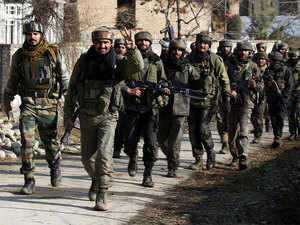 NEW DELHI: The bitter Doklam episode as well as the evolving regional security matrix forced India's defence brass in 2018 to hasten work on long-pending reforms and modernisation of the armed forces, resulting in a plethora of strategically key initiatives aimed at boosting India's military prowess
NEW DELHI: The bitter Doklam episode as well as the evolving regional security matrix forced India's defence brass in 2018 to hasten work on long-pending reforms and modernisation of the armed forces, resulting in a plethora of strategically key initiatives aimed at boosting India's military prowess
The efforts, however, were marred by the political firestorm over the Rafale deal with the defence ministry and the Indian Air Force having to focus on rebutting charges of graft in the Rs 58,000- crore contract.
As concerns mounted over Chinese infrastructure build-up in Tibet Autonomous Region and near Doklam tri-junction, the government expedited implementation of pending projects like laying of roads, construction of bridges, strengthening of key military airfields and enhancing surveillance along the nearly 3,600-km Sino-India border.
Another key move post Doklam crisis was the setting up of an institutional mechanism called the Defence Planning Committee (DPC) under the chairmanship of National Security Advisor Ajit Doval and having the foreign secretary, chairman of chiefs of staff committee and chiefs of the Army, Navy and the Air Force as its members.
The DPC has been tasked to make an "action plan" to effectively deal with various security challenges facing the nation and prepare drafts of national security strategy and doctrines.
However, the most talked about initiative of 2018 was the Indian Army's decision to carry out extensive and far reaching reforms with an aim to enhance its war-fighting capabilities and effectively deal with all possible challenges facing India along its borders with China and Pakistan.
The reform measures, seen as most significant in decades, will include downsizing of the second largest standing Army in the world and make it “leaner and meaner”, besides equipping the force with modern platforms and weapons.
The year also saw the Army finalising one of its biggest procurement plans for infantry modernisation under which a large number of light machine guns, battle carbines and assault rifles are being purchased at a cost of nearly Rs 40,000 crore to replace its ageing ..
According to official figures, the Army, Navy and the Air Force had demanded Rs 1.60 lakh crore as capital outlay in the 2018-19 budget, but were granted only Rs 83,434 crore.
In the year gone by, the Army procured M777 howitzers and K9 Vajra, in first major induction of artillery guns since Bofors guns were were inducted in mid 1980s.
However, a 10-year-old plan to acquire 2,600 future infantry combat vehicles for the Army at a cost of around Rs 60,000 crore stared at an uncertain future due divergent views among the stakeholders on its implementation.
Another ambitious programme to indigenously manufacture a fleet of modern battle tanks, christened as future ready combat vehicle, is also not moving forward due to procedural delays.
The Army pursued an aggressive anti-terror policy in Jammu and Kashmir and dealt firmly with almost all incidents of unprovoked firing by Pakistani forces along the Line of Control in Jammu and Kashmir.
Indian and Chinese troops also held their seventh round of military exercise which was suspended in 2018 following the Doklam standoff.
On the maritime front, the Navy significantly strengthened its presence of warships in the Indian Ocean region, and carried out a total of 35 multilateral and bilateral maritime exercise in the year. According to official figures, 33 Indian Navy ships are on deployment everyday on an average. The government is also eyeing to set up a naval base at Assumption Island in Seychelles.
No comments:
Post a Comment